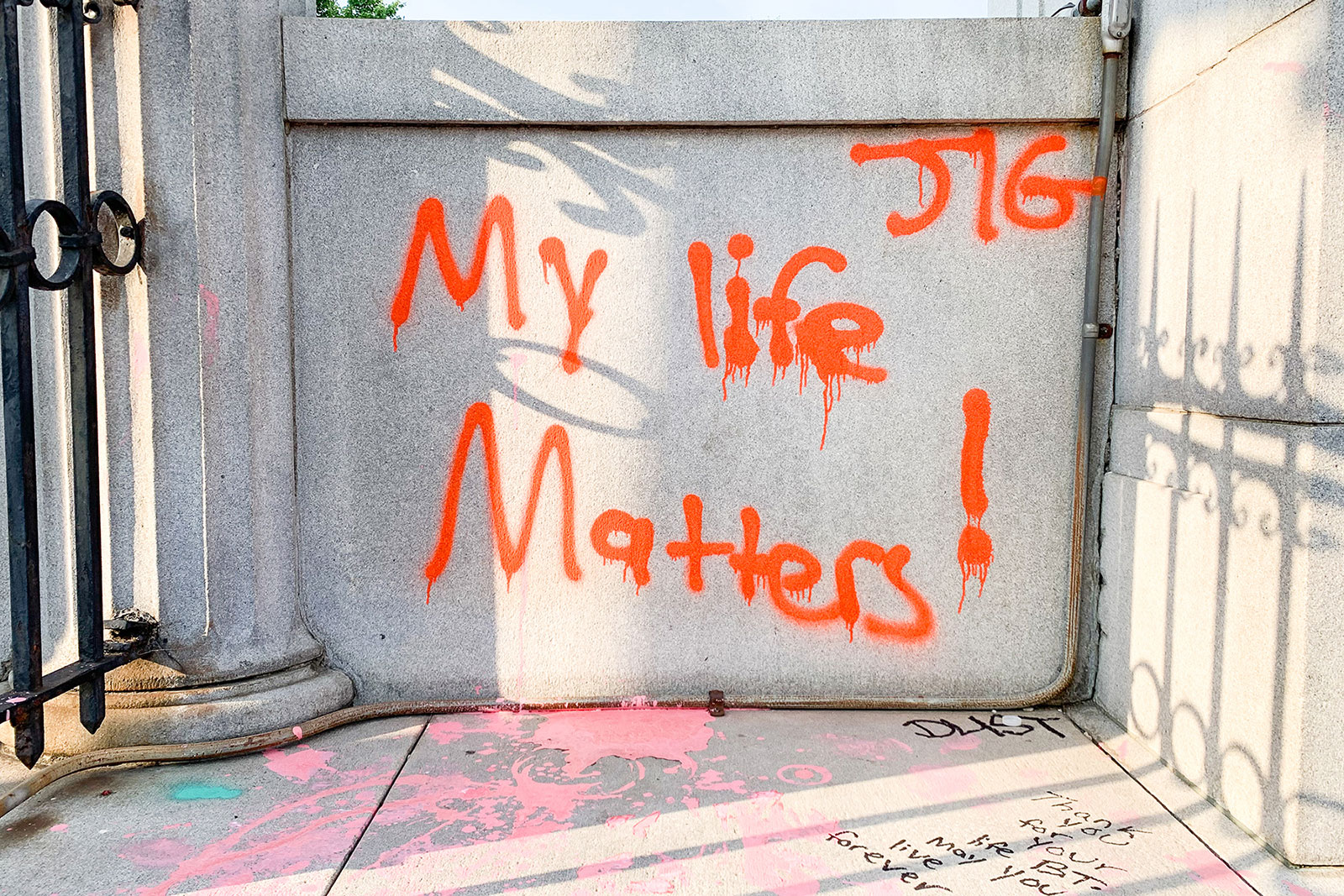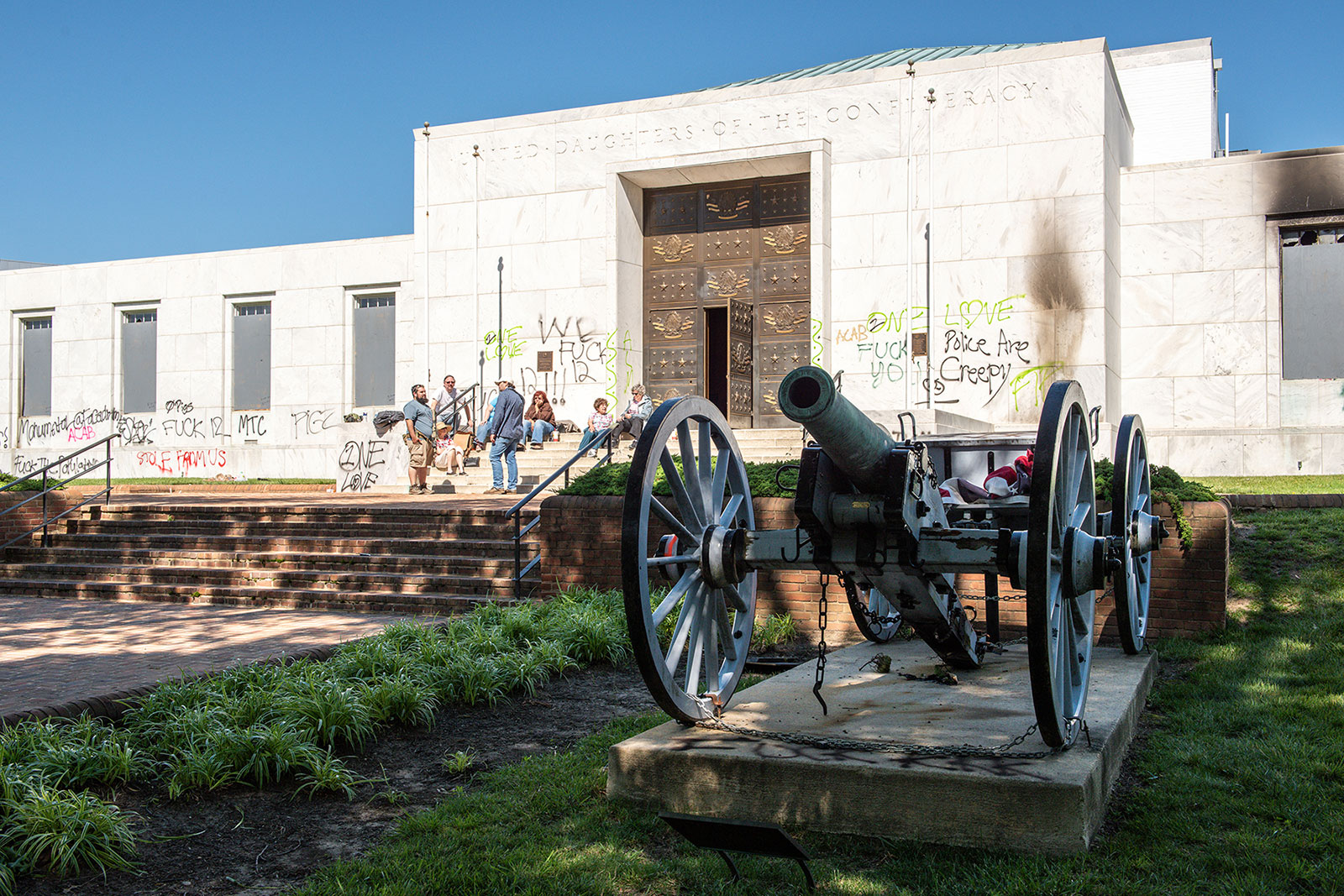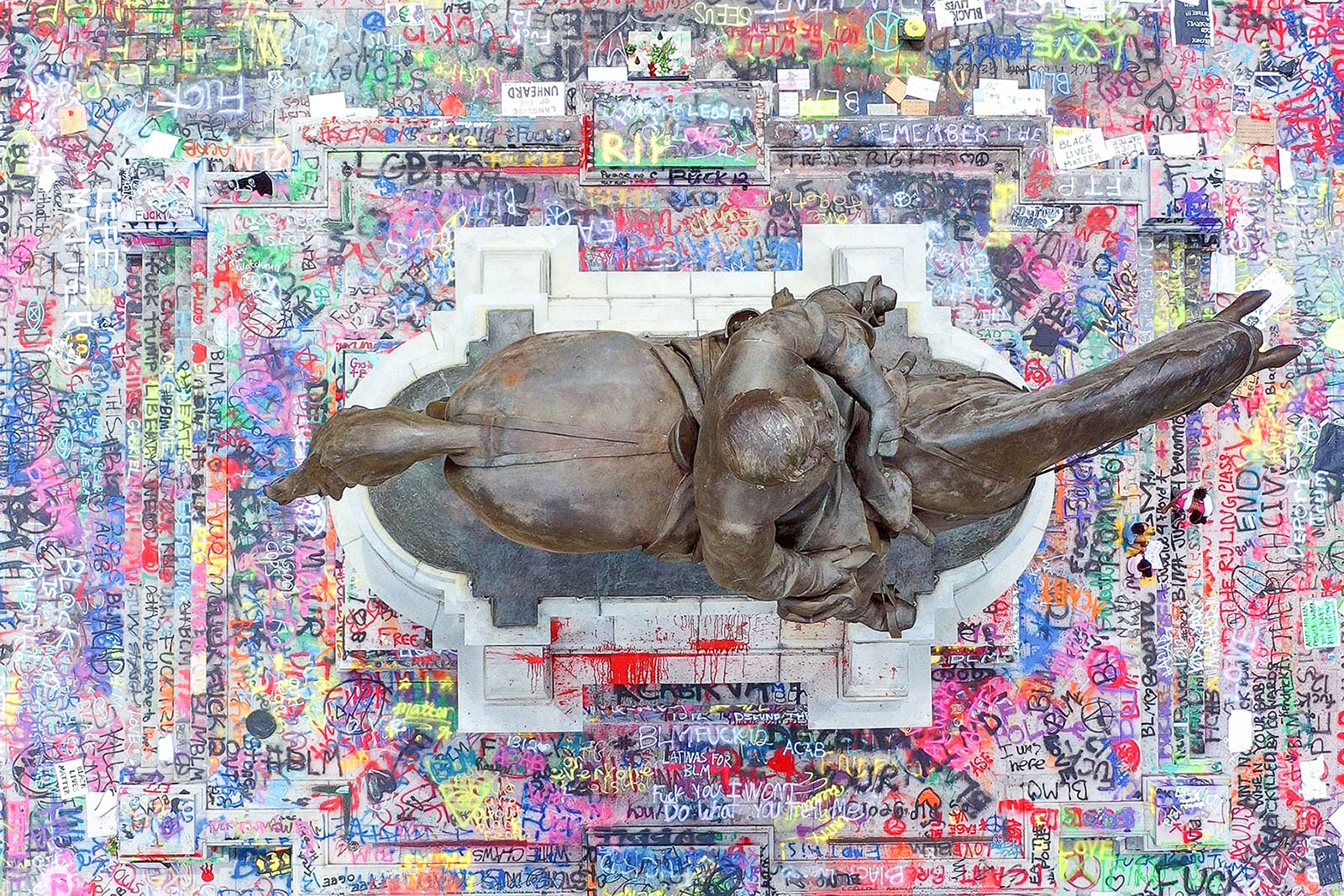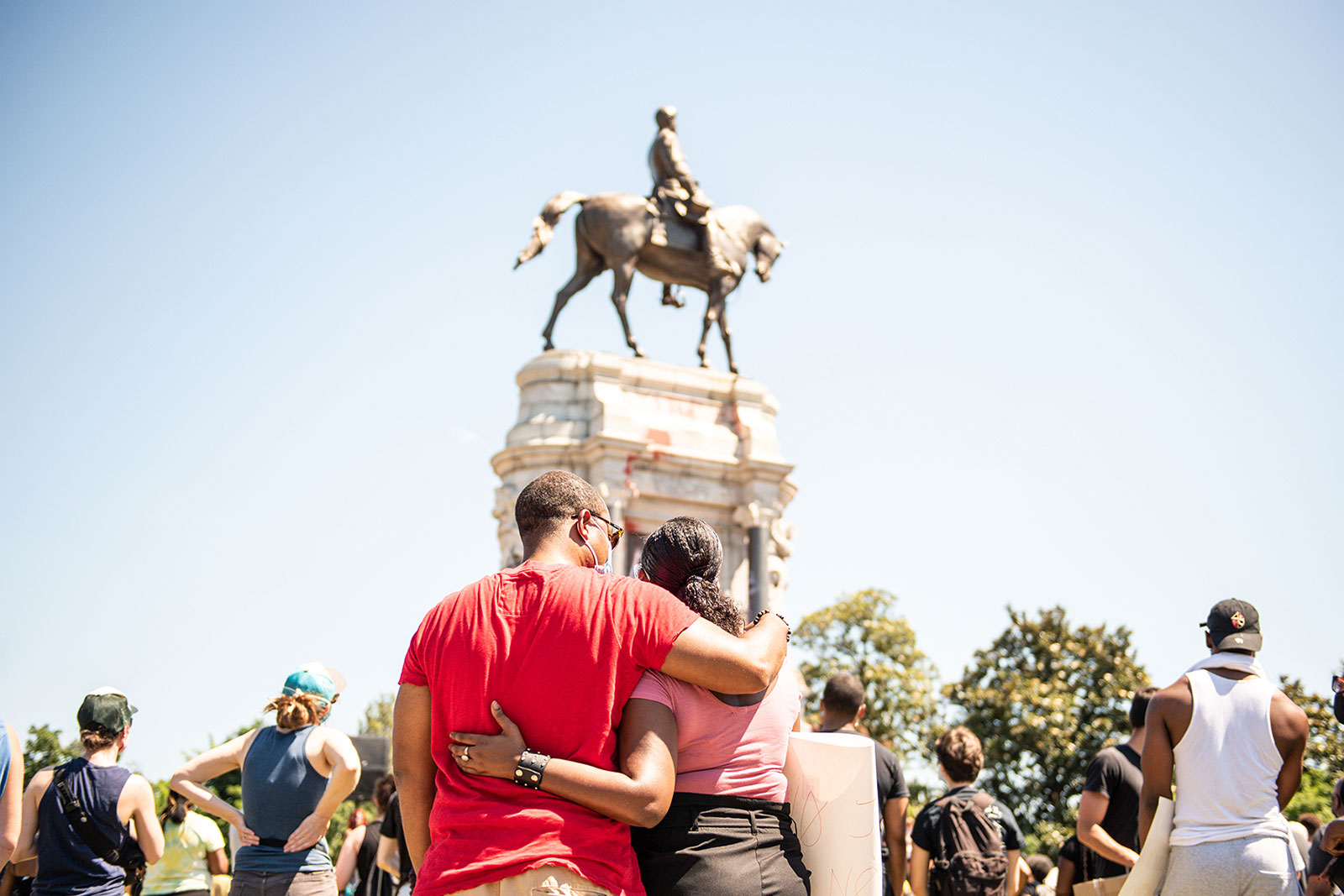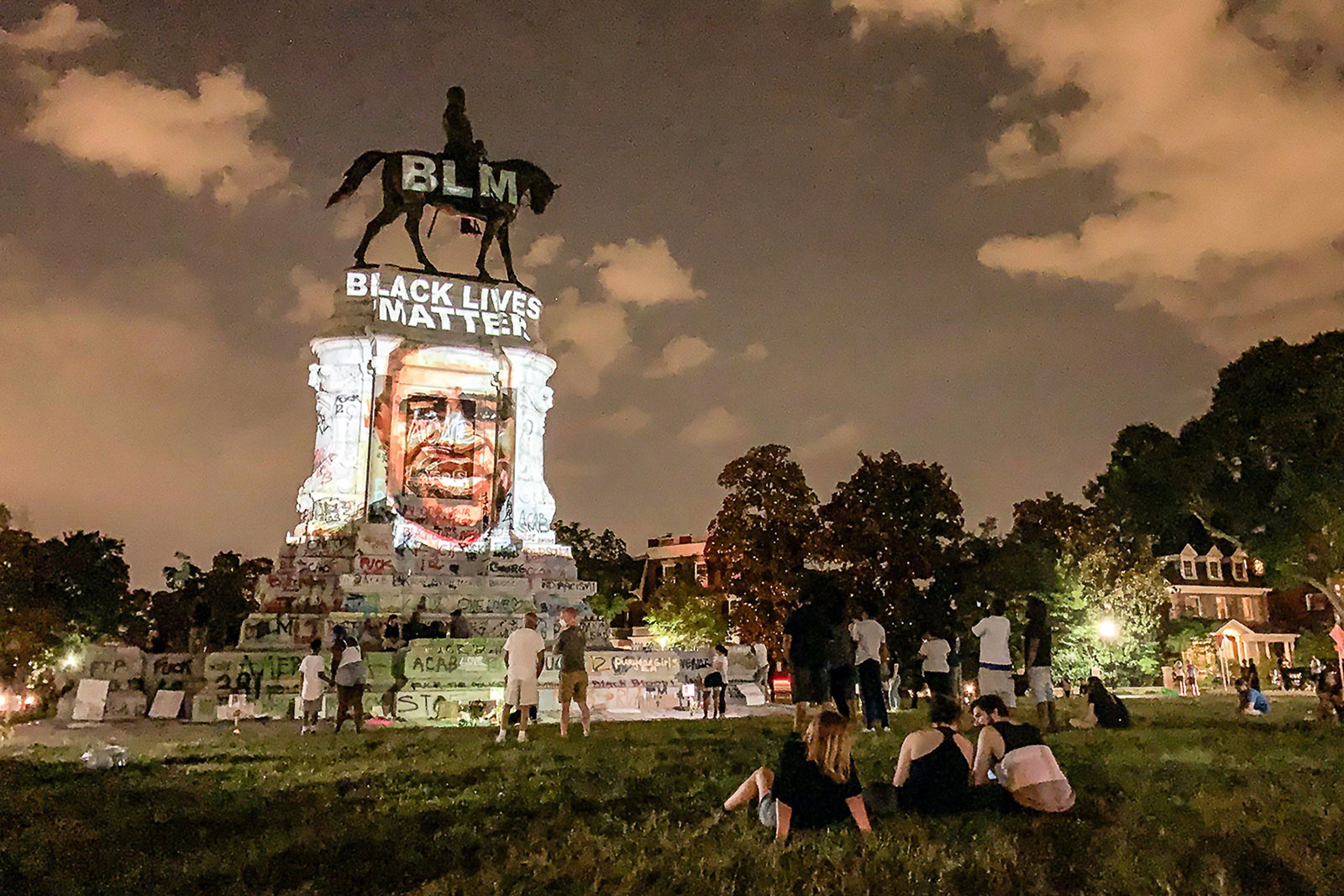Canceling the Confederacy
The dismantling of one of the most powerful brands in American history
On July 1, 2020, I stood with hundreds of masked observers to witness history in my hometown of Richmond, Virginia: the official removal of the first Confederate statue in our city.
A deluge of rain poured down, but spectators didn’t budge. We watched as a crane plucked a century-old bronze statue of Confederate general Stonewall Jackson from its 20-foot pedestal on Monument Avenue. Immediately at lift-off, I felt a momentous shift take place. The crowd erupted in cheers and applause. Church bells tolled. Even the heavens offered a resounding approval with a loud clap of thunder. This wasn’t just the removal of a statue. It was the elimination of a powerful symbol—a visual representation of a belief system with its own narrative, distinct set of values and unique personality; in short, a successful brand.
Having spent more than a decade working at ad agencies creating campaigns for national and global companies, I’ve seen firsthand the influence that brands have on people—for better and for worse.
Consider some of the top brands out there and the messaging they invoke. Coke invites us to “Taste the feeling,” Apple inspires us to “Think different,” and of course, Nike motivates us to “Just do it.” These brands make us feel something, strongly and viscerally. In fact, our emotions play a big role in why we buy a brand’s products and services. It’s also how we inadvertently become “brand ambassadors.” People see our advocacy in the choices we make—what we drink, the phone we use, the clothes we wear, the conversations we have, even the posts we like on social media.
The same holds true when a person becomes a brand, such as a celebrity or global figure. Their audience, in the form of fans or followers, become unofficial spokespeople. It’s why a red MAGA hat denotes so much more than a political party. It says to the world that you not only support that particular individual, but you believe in what they do, stand for what they stand for, and subscribe to their same ideology.
Branding is an effective marketing tool because it taps deep into our psyche, often without our realizing it. It can confirm what we already believe to be true, or it can be so persuasive that it changes our mind. In some cases, a brand stretches or distorts the truth to appeal to its audience. Do we really think Pop-Tarts are part of a nutritious breakfast, as Kellogg’s suggests? Over time, the reinforcement of this skewed reality becomes accepted as the norm. It’s exactly how the rise of the Confederacy brand came to pass.
Ultimately, behind every brand is an agenda—whether it’s turning a profit, gaining an audience, acquiring fame or power, promoting a cause, or perhaps all of the above. The way that agenda comes to life is typically through a “brand story,” a compelling narrative that elicits an emotional response, which in turn affects behavior. While I’d like to say humans are smart enough to recognize this subliminal sales pitch, we’re simple creatures who can be won over easily. Charles Revson, founder of the makeup brand Revlon, once stated, “In our factory, we make lipstick. In our store, we sell hope.”
When the Civil War ended, the Confederacy should have, too. But a belief system was already in place—one that included the justification of slavery—and it was profoundly ingrained in the minds of most white Southerners. The Confederates may have lost the war, but they were not about to give up on their version of America. They needed a way for the Confederacy to stay alive. In the world of advertising, it’s a well known strategy for a business to launch a new campaign when its brand starts to lose relevance, gets tied up in bad press, or in the case of the Confederacy, faces extinction.
In 2016, Wells Fargo created millions of fraudulent savings and checking accounts on behalf of clients without their consent. The multinational financial company admitted to breaking the law and was fined $3 billion. To recover from the scandal, the company modernized its logo and released a campaign emphasizing a new and improved commitment to customers. Through empathetic language and a tone of humility, Wells Fargo attempted to transform its image from evil banking behemoth to trusted banking friend. Only time will tell if it proves successful.
Branding is a marathon, not a sprint. It can take years to build an impactful brand (or rebrand). It’s why we know BMW is “The ultimate driving machine” and that we’ll be “in good hands with Allstate”—both slogans have been running for more than 40 years. De Beers has been telling us “A diamond is forever” since 1947. From “Have it your way” to “The happiest place on Earth,” the way brands become part of our cultural landscape is through the story they consistently tell us over time.
Enter the Lost Cause, an interpretation of the Civil War developed during post-Reconstruction by white Southerners, many of whom were former Confederate generals. The sole aim of this one-sided narrative was to paint the Confederacy in the best possible light. Marketers call this “brand positioning”—the way in which a brand is perceived in the minds of its audience. For the Confederates, this meant writing their own version of history.
The primary purpose of the Lost Cause was to establish the belief that the Confederacy fought for a just and heroic cause—specifically, states’ rights. Downplaying support of institutionalized slavery, it emphasized Confederate bravery and the struggle for independence. In this romanticized version of the Old South, the “brand personality” of the Confederacy began to take shape. By applying human traits and characteristics, the brand became more relatable, inspiring more empathy. Serving up Confederate war efforts as noble and virtuous strengthened the brand’s emotional connection to white Southerners by tapping into their longstanding pride.
The Lost Cause also weaved in guiding principles to perpetuate a more honorable and respected image. These “brand values” highlighted what was important to Southerners: devotion to family and state, faithfulness to Christian ideals, and preservation of the life and culture of the Antebellum South, characterized by plantation fields, sweet tea, good manners and “happy” slaves.
When brand values, personality and positioning come together, they work to promote what is known as the “brand promise.” This is the expectation a brand sets for itself to motivate its audience to support, and ideally, champion its cause. For the Confederacy, that promise came to fruition in a brand slogan created by a Southern political coalition known as the Redeemers. “The South will rise again” became the Confederate rallying cry. Depending on whether you were white or Black, the phrase was either a vision for the future or a threat to your very existence.
As the Confederate brand further solidified, its followers sought out the most effective way to push their agenda out into the world. Essentially a “brand launch campaign,” the Confederacy used specific mediums (“media channels”) to communicate its message to the widest audience possible. Back in the late 1800s, there was obviously no social media, influencer marketing or commercials. However, the United Daughters of the Confederacy (UDC), a white Southern women’s “heritage” group, found a solution that would not only preserve the legacy of the Confederacy, but validate it. Their primary media channel: school textbooks.
The UDC argued that the historical narrative around the Civil War dishonored the South in a legacy of shame. As such, they referred to the war as the War Between the States or the War for Southern Independence. This is an example of “rebranding”—a marketing strategy that allocates a different identity for a brand; one that works more in its favor. By pushing for the Lost Cause narrative in the classroom, the Confederates were able to reach children at the origin point of their education, indoctrinating them with a biased perspective of U.S. history. This systematic method of changing attitudes or altering beliefs is often known by another term: brainwashing.
The Lost Cause still remains in some present-day textbooks. The goal of the UDC wasn’t just to rewrite history for the South, but for the entire nation. They wanted to ensure generations grew up knowing their version of the “truth.” But they didn’t stop there. There was a desire to build something permanent and highly visible to maintain the Confederacy’s relevance. As such, the UDC led the movement to erect memorials to Confederate veterans in public spaces all over the country during two distinct time periods.
The first wave of Confederate statues was built during The Progressive Era (1890-1921). Slavery was abolished, but the South was determined to keep Black people oppressed through Jim Crow laws that legalized and enforced racial segregation. The proliferation of memorials to the Confederacy kept the brand visible, while serving as an intimidation tactic (for context, the UDC also built a memorial commemorating the Ku Klux Klan). Around this same time, an unprecedented number of lynchings took place. These killings were public acts of racial terror committed by white Southerners to incite fear among newly freed slaves. In some cases, white people who enabled Black people were lynched as well.
The second wave of Confederate statues was built during the Civil Rights Movement (1954-68). Black people were justifiably fed up with the continued inequality stemming from the country’s inherent prejudice. After World War II, a group of white Southern Democrats briefly formed their own far-right political party called the Dixiecrats. Opposing racial integration, they supported Jim Crow laws and pledged to uphold white supremacy. The party’s symbol: the Confederate battle flag (also known as the Rebel flag.) Resurrected after nearly 100 years out of the public eye, it sent a message loud and clear: defiance against racial equality.
Today, more than 1,500 Confederate symbols exist in the United States, with over 240 in Virginia alone, more than any other state. Most are statues of Confederate leaders or soldiers from the Civil War, put in prominent spaces for public display. The Confederacy also found its way into the names of schools, roads, parks, bridges and of all places, military bases. Confederate museums popped up, serving as shrines to protect the “legacy” of the war, but again, only showcasing the point of view of the South.
Until a few months ago, the Virginia Flaggers, a neo-Confederate group based in Richmond, would gather on a highly visible corner of Arthur Ashe Boulevard, near the UDC national headquarters (yes, the UDC still exists). According to an article in the Daily Beast, some members of the Virginia Flaggers are directly tied to white nationalist groups that openly promote white supremacy. Typically, the scene would consist of a few older white men and a lineup of parked trucks flying multiple Confederate flags from 10-foot poles. In recent years, they had added a giant Trump flag to their collection. However, since the resurgence of the Black Lives Matter (BLM) movement and protests, the Flaggers have been absent. From a branding perspective, a lack of visibility is a sure sign a brand is losing relevance. Out of sight, out of mind.
For more than a century, the Confederacy built and strengthened its brand through textbooks, monuments, flags and more. Eventually, it made its way into pop culture. In the 1980s, the country band Alabama released the song “Dixieland Delight.” The feel-good song became popular with students at the University of Alabama, who began singing it during football games. When they added their own profanity-laced lyrics, the school momentarily banned the tradition. Ironically, no one seemed to have a problem with the actual name of the song, “Dixieland,” a nickname referring to the 11 Southern states that seceded to form the Confederate States of America. In fact, it wasn’t long ago that fraternities at the University of Alabama, and other Southern universities, held “Old South” themed parties and parades. Revelers dressed in Civil War attire with women in Scarlet O’Hara-like hoop skirts and men in Confederate gray military uniforms.
Growing up, I couldn’t get enough of The Dukes of Hazzard, an action-packed TV show featuring the adventures of brothers Bo and Luke Duke, two good ol’ boys who ran a moonshine business for their Uncle Jesse in rural Georgia. Mostly, the show was watching them evade the law by driving around in their 1969 Dodge Charger, named the “General Lee” after Confederate general Robert E. Lee. The car had a Confederate flag painted on the roof and a signature horn that played the first few notes of “Dixie,” the de facto national anthem of the Confederacy. In 2005, Warner Brothers released a feature film based on the hit series. Reruns of the show continued to play on TV Land until 2015, when white supremacist Dylann Roof stormed a church in South Carolina, killing nine Black people for the explicit purpose of starting a race war. Photos later surfaced of him posing at a historic Civil War site, holding the gun he used in the massacre, along with a Confederate flag.
Brands are powerful because of the complex idea system behind them. A quick search on Amazon shows the Confederacy’s fight to stay alive. Branded merchandise ranges from Confederate T-shirts and throw pillows to commemorative coins and face masks—even the Dixie Air Horn is available. From generation to generation, the Confederacy brand and its racist ideology have continued to exist. As a society, we’ve failed to bring the truth to the masses. Instead, we’ve succumbed to the branding. Our tolerance, and in some cases indifference, have translated into acceptance. A brand reaches the pinnacle of success when it becomes a normal part of everyday life—when people carry around the ubiquitous Starbucks coffee cup, talk about their latest run to Targé [“tar-jay”], or when a reality show host becomes president of the United States and defends the statues of traitors proliferating our country.
But the normalization can end when the narrative changes. And that’s precisely what happened on May 25, 2020, when Minneapolis police killed George Floyd.
The momentum of protests that erupted across the country quickly made its way to Richmond, former capital of the Confederacy. Nowhere has the Confederacy been more visible in the city than on Monument Avenue, a grand, tree-lined boulevard featuring five enormous statues dedicated to Confederate military and political figures. Over the years, numerous efforts have been made to remove or relocate the statues, or use historical plaques to provide context. It wasn’t until protesters began to tear down statues around town that Mayor Levar Stoney announced a proposal to officially remove all Confederate statues from Monument Avenue, stating that “Richmond is no longer the capital of the Confederacy—it is filled with diversity and love for all, and we need to demonstrate that.”
In less than a month, four of the five statues were removed. Now, only General Robert E. Lee remains, due to a court order protecting it that is expected to be lifted. The Confederate general on horseback sits perched atop a 60-foot pedestal covered in an impactful array of colorful graffiti. Finally, “context” has been added. While a few complain about the profanity, most recognize the profound meaning behind the messages. Centuries of pain, injustice, anger, grief and trauma are finally being unleashed and recognized, culminating in a beautiful expression that is ultimately about hope.
Photographer John Biggs used a drone to capture an incredible, abstract aerial shot of the Lee Monument. A yoga friend of mine remarked that the colors and textures resemble a mandala, the sacred symbol in Hindu and Buddhist rituals, that also represents a sacred space. It’s a poignant analogy that demonstrates how a change in perspective (both literally and figuratively) can open the mind to see things in an entirely new light. It’s precisely what we need right now.
A video clip has been trending from the beloved 1980s sitcom The Golden Girls, featuring the friendship of four senior women living in Florida. The clip shows one of the main characters, Blanche Devereaux (played by Rue McClanahan), being confronted by a young Don Cheadle, who gives her a lesson in racism, prompted by her display of the Confederate flag.
As Blanche attempts to defend her Southern heritage, she quickly realizes her predicament with the flag’s racist ties. Clearly having an existential crisis, she pleads, “What am I supposed to do and think about my family now? What am I supposed to think about all those people I love? What am I supposed to think about ME? Everything I grew up believing in, all my wonderful memories, they’re all tarnished now by …” She pauses for a moment to consider the weight of the moment. “Oh god … by the truth.”
For many, this time has been an awakening as a new, more accurate historical narrative takes shape. In a display of poetic justice, the area where the Lee Monument stands on Monument Avenue in Richmond has been rebranded as Marcus-David Peters (MDP) Circle. The new community gathering spot is named after a 24-year-old local Black man and high school teacher, who was having a mental health crisis when a Richmond police officer shot and killed him in May 2018. He is our George Floyd.
At the center of MDP Circle, makeshift memorials have been built, featuring Black people from across the country who have died from police brutality. Their photos are accompanied by bios that tell their stories and the injustice of their deaths.
On a daily basis, people come here to learn, cry, contemplate and rejoice. They take photos, have conversations, enjoy a picnic, and play pickup basketball games. The location has served as a venue for lectures, dance and music performances, and yoga practices. A community garden has been started, and volunteers under tents regularly offer water and snacks and information on ways to take action and register to vote. In the evenings, a local lighting artist uses the Lee statue as a backdrop for the projection of the faces of Black victims, alongside Black activists, thinkers and politicians, to reclaim support for the BLM movement.
I wonder, if Lee were alive today, what he might think of his statue’s transformation. Considering he opposed monuments, specifically Confederate war monuments, my hope is he’d recognize the irony. Certainly his descendents do. Rev. Robert Wright Lee, a distant nephew of the Confederate general, has voiced support for removal of the statues for years stating, “I fully believe, along with a host of other amazing citizens of this great country, that Black lives matter—and for us to continue to celebrate a man who questioned the education, disparaged the right to vote of Black life, and had previously fought for the continued enslavement of Africans on the North American continent is an affront to those now suffering under the continued weight of oppression.”
This is how we begin to re-educate a nation. This is how we seek the truth. Already we’re seeing visible signs of change nationwide. Confederate statues are coming down, Black Lives Matter murals are going up. Police reform and accountability are being discussed. Corporate America is taking a stance and rethinking policies and practices. And many are taking a serious look at their branding. In just the last few months, NASCAR has banned Confederate flags at all races and events, the Dixie Chicks are now the Chicks, the Washington Redskins plan to change their name and logo, and Aunt Jemima, Uncle Ben’s and Cream of Wheat are among a number of brands looking to update their image.
Finally, we’ve reached a tipping point that is changing our acceptance into action. This is the revolution our country needs. Make no mistake, symbolic changes will not get rid of the systematic racism that continues to prevail in this country. Police brutality isn’t just happening in the South—it’s happening all over the country, including in liberal cities like Minneapolis. After all, our history of colonization and the racist ideology of white supremacy aren’t exclusive instruments to the Confederacy brand, but to the brand of the entire United States of America.
Yet there is hope. Through these challenging times, our nation is evolving. We are beginning to acknowledge and understand our past, not from a single narrative, but from multiple perspectives. It’s human nature for people to believe what they want to believe, even if it means ignoring the truth. But there is no growth, empathy or understanding in ignorance. The only way of moving toward a more equitable future is by empowering ourselves—and others—through knowledge.
Branding is not the truth. It’s an interpretation—in some cases, an illusion that holds great power, as witnessed by the rise of the Confederacy brand. We live in a time with incredible access to information, yet the lines between fact and fiction are blurred more than ever. That’s why it’s up to us to take individual responsibility—not only as responsible consumers, but as informed citizens. We must question what is normalized, look past the persuasive narrative, and never stop seeking the truth.
To learn more about this topic, consider reading Stamped from the Beginning: The Definitive History of Racist Ideas in America by Dr. Ibram Kendi. Below are additional resources that informed this article:
• Newsweek: Confederate General Robert E. Lee’s Descendant Says Statues ‘Must Be Removed’ and ‘We Cannot Remain Complicit’ (July 2020)
• Insider: Photos show how the Robert E. Lee statue in Virginia has been reclaimed to support the Black Lives Matter movement (July 2020)
• CNN: NFL’s Washington Redskins will change name and logo, team says (July 2020)
• FiveThirtyEight: Confederate Statues Were Never Really About Preserving History (July 2020)
• Business Insider: 26 simple charts to show friends and family who aren’t convinced racism is still a problem in America (July 2020)
• The Progressive: The Story Behind the Lee Statue in Richmond, Virginia (July 2020)
• Birmingham Watch: Daughters of Confederacy Put Up Statues, Indoctrinated Generations, Historians Say (July 2020)
• The New Yorker: Europe in 1989, America in 2020, and the Death of the Lost Cause (July 2020)
• Washington Post: Trump’s ardent defense of Confederate monuments continues as Americans swing the opposite direction (July 2020)
• Fan Buzz: “Dixieland Delight” Makes Alabama Fans Go Wild Any Time of Year (July 2020)
• Politico: Why the Descendants of Confederate Generals Are Happy to See Their Names Go (July 2020)
• National Geographic: As monuments fall, how does the world reckon with a racist past? (June 2020)
• BBC News: George Floyd: Timeline of black deaths caused by police (June 2020)
• NPR: Dixie Chicks Change Band Name To The Chicks (June 2020)
• Vox: The Night They’ll Tear Old Dixie Down (June 2020)
• Washington Post: There is no earthly reason this nation should be defiled by Confederate statues (June 2020)
• The Atlantic: The Confederacy Was an Antidemocratic, Centralized State (June 2020)
• Market Watch: Aunt Jemima, Uncle Ben’s, Cream of Wheat Mrs. Butterworth’s reveal plans to rebrand: A look back at their racist origins (June 2020)
• Milwaukee Independent: A Legacy of Lies: “Lost Cause” Myth Distorted Civil War History to Infect America’s Soul with White Supremacy (June 2020)
• The Atlantic: Richmond’s Confederate Monuments Were Used to Sell a Segregated Neighborhood (June 2020)
• CNN: NASCAR bans Confederate flags at all races, events (June 2020)
• CNN: Washington, DC Paints A Giant ‘Black Lives Matter’ Message on the Road to the White House (June 2020)
• The New York Times: How Minneapolis, One of America’s Most Liberal Cities, Struggles With Racism (June 2020)
• Washington Post: How the ‘Lost Cause’ narrative became American history (March 2020)
• Facing South: Twisted Sources: How Confederate propaganda ended up in the South’s schoolbooks (April 2019)
• Southern Poverty Law Center: Whose Heritage? Public Symbols of the Confederacy (February 2019)
• Salon: 7 things the United Daughters of the Confederacy might not want you to know about them (October 2018)
• Facing South: The group behind Confederate monuments also built a memorial to the Klan (June 2018)
• Richmond Times-Dispatch: Happy slaves? The peculiar story of three Virginia school textbooks (April 2018)
• Smithsonian Magazine: How I Learned About the “Cult of the Lost Cause” (March 2018)
• Smithsonian Magazine: The Costs of the Confederacy (December 2018)
• Time: The Civil War Never Stopped Being Fought in America’s Classrooms. Here’s Why That Matters (November 2017)
• Vox: How Southern socialites rewrote Civil War history (October 2017)
• Vice: How White Women Are Responsible for the Confederate Monuments We Have Today (September 2017)
• PBS: Robert E. Lee opposed Confederate monuments (August 2017)
• The Daily Beast: The South Shall Not Rise Again (April 2017)
• The Daily Beast: For the Virginia Flaggers, It’s Hate, Not Heritage (April 2017)
• Encyclopedia Virginia: The Lost Cause (July 2016)
• The Atlantic: Confederate Flag, Pop-Culture Phenomenon (June 2015)
• The Atlantic: Why Is the Flag Still There? (June 2015)








